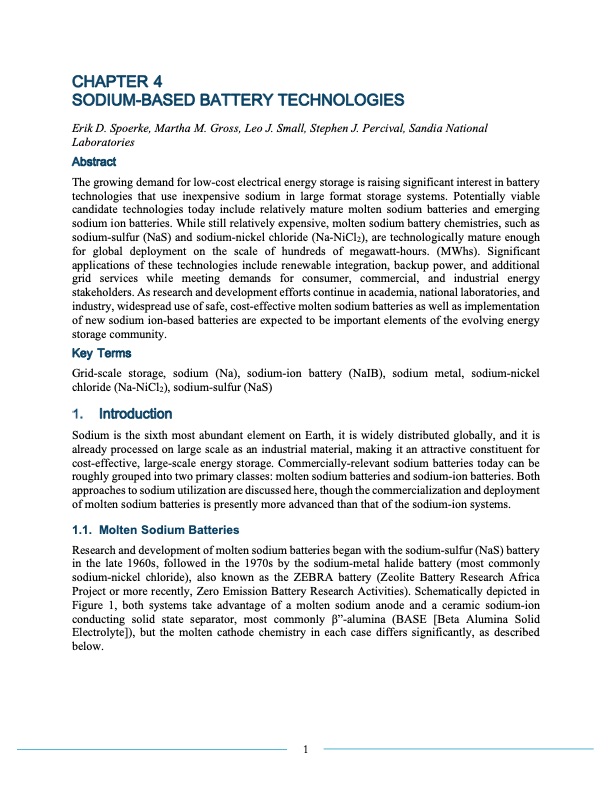
PDF Publication Title:
Text from PDF Page: 001
CHAPTER 4 SODIUM-BASED BATTERY TECHNOLOGIES Erik D. Spoerke, Martha M. Gross, Leo J. Small, Stephen J. Percival, Sandia National Laboratories Abstract The growing demand for low-cost electrical energy storage is raising significant interest in battery technologies that use inexpensive sodium in large format storage systems. Potentially viable candidate technologies today include relatively mature molten sodium batteries and emerging sodium ion batteries. While still relatively expensive, molten sodium battery chemistries, such as sodium-sulfur (NaS) and sodium-nickel chloride (Na-NiCl2), are technologically mature enough for global deployment on the scale of hundreds of megawatt-hours. (MWhs). Significant applications of these technologies include renewable integration, backup power, and additional grid services while meeting demands for consumer, commercial, and industrial energy stakeholders. As research and development efforts continue in academia, national laboratories, and industry, widespread use of safe, cost-effective molten sodium batteries as well as implementation of new sodium ion-based batteries are expected to be important elements of the evolving energy storage community. Key Terms Grid-scale storage, sodium (Na), sodium-ion battery (NaIB), sodium metal, sodium-nickel chloride (Na-NiCl2), sodium-sulfur (NaS) Introduction Sodium is the sixth most abundant element on Earth, it is widely distributed globally, and it is already processed on large scale as an industrial material, making it an attractive constituent for cost-effective, large-scale energy storage. Commercially-relevant sodium batteries today can be roughly grouped into two primary classes: molten sodium batteries and sodium-ion batteries. Both approaches to sodium utilization are discussed here, though the commercialization and deployment of molten sodium batteries is presently more advanced than that of the sodium-ion systems. 1.1. Molten Sodium Batteries Research and development of molten sodium batteries began with the sodium-sulfur (NaS) battery in the late 1960s, followed in the 1970s by the sodium-metal halide battery (most commonly sodium-nickel chloride), also known as the ZEBRA battery (Zeolite Battery Research Africa Project or more recently, Zero Emission Battery Research Activities). Schematically depicted in Figure 1, both systems take advantage of a molten sodium anode and a ceramic sodium-ion conducting solid state separator, most commonly β”-alumina (BASE [Beta Alumina Solid Electrolyte]), but the molten cathode chemistry in each case differs significantly, as described below. 1PDF Image | SODIUM-BASED BATTERY TECHNOLOGIES CH 4

PDF Search Title:
SODIUM-BASED BATTERY TECHNOLOGIES CH 4Original File Name Searched:
ESHB_Ch4_Sodium_Spoerke-1.pdfDIY PDF Search: Google It | Yahoo | Bing
Salgenx Redox Flow Battery Technology: Salt water flow battery technology with low cost and great energy density that can be used for power storage and thermal storage. Let us de-risk your production using our license. Our aqueous flow battery is less cost than Tesla Megapack and available faster. Redox flow battery. No membrane needed like with Vanadium, or Bromine. Salgenx flow battery
| CONTACT TEL: 608-238-6001 Email: greg@salgenx.com | RSS | AMP |